
Home
Visiting
- Where We Are
- Timetable and Fares
- History of the Line
- The Journey
- Warcop Emporium
- Buffer Stop Refreshments
- Model Railways
- Contact Us
Rolling Stock
Helping the Railway
Miscellany
- GB2EVR and ROTA
- Emporium on the Road
- The Railway from Above
- EVR on the Radio
- The Cumbrian Boat Train
Galleries
Links


Motive Power
37042
47799
DEMU: 205009
Motor Luggage Vans (S68003, S68005 and S68010)
Darlington (RSHD8343/1962)
21 (JF4220045/1967)
ND3815 (Hunslet 2389/1941)
Thomas Hill 130c/1963
Drewry Cars 2181/1945
Crane and Match Wagon (DRT81343 and DS70281)
Wickham Trolley (DE320468)
Fred: The Railbike
Note that the 4-CEPs are used as coaching stock and so are included on the Coaching Stock page
37042
Built by English Electric at their Vulcan Works in Lancashire in 1962, works number EE/VF 3034/D696, the loco entered service in June 1962 as D6742, allocated to Darnall shed in Sheffield. During a nomadic life the loco was allocated to Cardiff Canton, March, Healey Mills, Thornaby, Tinsley and Immingham. On the introduction of TOPS it was renumbered 37042. Although primarily a freight locomotive, D6742/37042 made regular appearances on passenger trains, something which continued until 2004 when it spent two days on Arriva Trains' Leeds - Carlisle loco hauled services with 37411.
On the break up of British Rail 37042 passed to EWS. It was transferred to the reserve fleet in 2004 before being put into storage in 2007 and finally being sold for preservation in early 2011. 37042 arrived at Warcop in April 2011 and is awaiting restoration.
Far more details of the loco's history can be found at the Class 37 Locomotive Data website
37042 at Warcop, April 2011
47799
DEMU: 205009
Motor Luggage Vans (S68003, S68005 and S68010)
Darlington (RSHD8343/1962)
21 (JF4220045/1967)
ND3815 (Hunslet 2389/1941)
Thomas Hill 130c/1963
Drewry Cars 2181/1945
Crane and Match Wagon (DRT81343 and DS70281)
Wickham Trolley (DE320468)
Fred: The Railbike
Note that the 4-CEPs are used as coaching stock and so are included on the Coaching Stock page
37042
Built by English Electric at their Vulcan Works in Lancashire in 1962, works number EE/VF 3034/D696, the loco entered service in June 1962 as D6742, allocated to Darnall shed in Sheffield. During a nomadic life the loco was allocated to Cardiff Canton, March, Healey Mills, Thornaby, Tinsley and Immingham. On the introduction of TOPS it was renumbered 37042. Although primarily a freight locomotive, D6742/37042 made regular appearances on passenger trains, something which continued until 2004 when it spent two days on Arriva Trains' Leeds - Carlisle loco hauled services with 37411.
On the break up of British Rail 37042 passed to EWS. It was transferred to the reserve fleet in 2004 before being put into storage in 2007 and finally being sold for preservation in early 2011. 37042 arrived at Warcop in April 2011 and is awaiting restoration.
Far more details of the loco's history can be found at the Class 37 Locomotive Data website
37042 at Warcop, April 2011
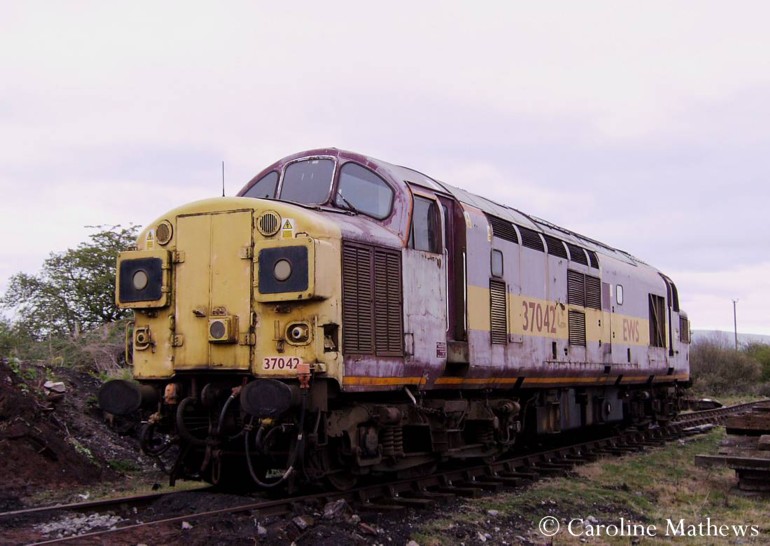
47799 (Prince Henry)
47799 is one of the once numerous Brush Type 4 class which later became Class 47. It was built at BR Crewe works and entered service in February 1965 as D1654 based at Swansea Landore depot. Although it was allocated to several depots over the next 20 years it remained in the Western Region of British Rail. The first renumbering of the loco took place in February 1974 when it became 47070 and there was a second renumbering, to 47620, in September 1984.
The loco was nameless until being named “Windsor Castle” at Paddington Station on 26th July 1985, the ceremony being carried out by Her Majesty the Queen. This name was retained when the loco was renumbered to 47835 in December 1989, the renumbering indicating the fitting of long range fuel tanks for Inter-City passenger work.
Yet another change occurred in May 1995, when the loco was designated as one of two to be dedicated to Royal Train duties. The name “Windsor Castle” was removed and the loco renamed “Prince Henry” and renumbered to 47799: this naming apparently took place with no ceremony at Crewe Depot! The other Royal Train loco, 47798, was named Prince William and is now in the National Collection.
47799 was used for Royal Trains, VSOE and Pullman Charters and occasional “ordinary” passenger trains until February 2004 when two Class 67 locomotives took over Royal duties. In recent years 47799 was based at Eastleigh and used for providing power and heat to coaching stock at Eastleigh Works.
The locomotive arrived at Warcop in December 2011: a full set of photographs documenting the locomotive's arrival can be seen in this Smugmug Gallery
47799 is still in Royal livery but the cast plates with the name, number, company logo, royal crest and “by royal appointment” notice were removed prior to the move to Warcop. The loco is currently undergoing re-wiring and is out of action at the moment.
More detail about 47799 at the Class 47 website
47799 on the day of its arrival at Warcop, 22nd December 2011
47799 is one of the once numerous Brush Type 4 class which later became Class 47. It was built at BR Crewe works and entered service in February 1965 as D1654 based at Swansea Landore depot. Although it was allocated to several depots over the next 20 years it remained in the Western Region of British Rail. The first renumbering of the loco took place in February 1974 when it became 47070 and there was a second renumbering, to 47620, in September 1984.
The loco was nameless until being named “Windsor Castle” at Paddington Station on 26th July 1985, the ceremony being carried out by Her Majesty the Queen. This name was retained when the loco was renumbered to 47835 in December 1989, the renumbering indicating the fitting of long range fuel tanks for Inter-City passenger work.
Yet another change occurred in May 1995, when the loco was designated as one of two to be dedicated to Royal Train duties. The name “Windsor Castle” was removed and the loco renamed “Prince Henry” and renumbered to 47799: this naming apparently took place with no ceremony at Crewe Depot! The other Royal Train loco, 47798, was named Prince William and is now in the National Collection.
47799 was used for Royal Trains, VSOE and Pullman Charters and occasional “ordinary” passenger trains until February 2004 when two Class 67 locomotives took over Royal duties. In recent years 47799 was based at Eastleigh and used for providing power and heat to coaching stock at Eastleigh Works.
The locomotive arrived at Warcop in December 2011: a full set of photographs documenting the locomotive's arrival can be seen in this Smugmug Gallery
47799 is still in Royal livery but the cast plates with the name, number, company logo, royal crest and “by royal appointment” notice were removed prior to the move to Warcop. The loco is currently undergoing re-wiring and is out of action at the moment.
More detail about 47799 at the Class 47 website
47799 on the day of its arrival at Warcop, 22nd December 2011
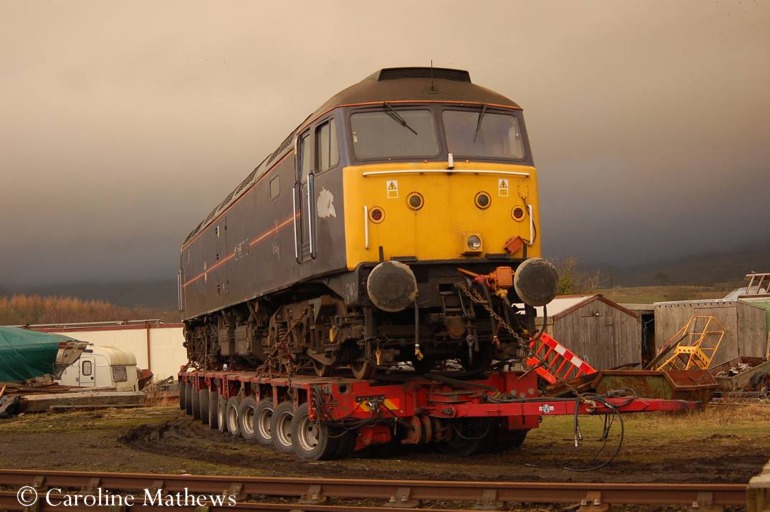
47799 in Wild Boar Cutting on 13th April 2013, with the line towards Sandford Bridge in the background.
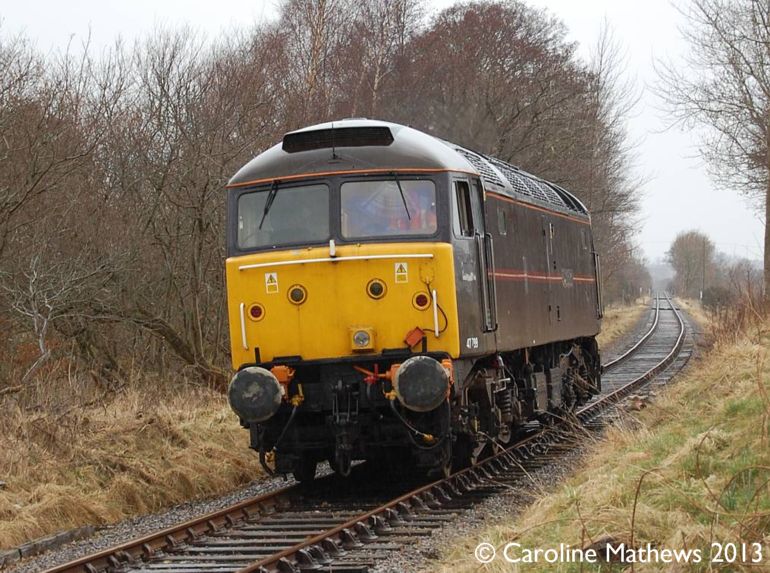
Diesel Electric Multiple Unit “Thumper” 205009
Originally built in 1957 at Eastleigh as two car unit 1109 consisting of driving motor brake second open (DMBSO) 60108 and driving trailer composite (DTC) 60808, and classified as a 2H. One of a batch of 18 built for the Portsmouth to Salisbury and Andover service and the Alton to Winchester and Southampton service, increasing passenger numbers meant that a third car was added to each, the TSO added to 1109 being numbered 60658.
When TOPS was introduced 1109 became 205 009 and it continued to work for British Rail and Connex until late 2004 when it was purchased for preservation on the Eden Valley Railway, being delivered in March 2005 by rail via the link between the Eden Valley Railway and the Settle & Carlisle line at Appleby.
205009 is currently in service and operates the majority of passenger services at the Eden Valley Railway. Having been in a dark green livery (on the passenger side, anyway) whcih was applied to cover up the graffiti it received in the south of England when it first arrived at Warcop it has now been repainted into a rather brighter, if non-authentic, livery.
A detailed photographic history of the Class 205 multiple units can be found on the Southern Railway E-mail Group (SREmG) website.
205009 on delivery on the short stretch of the Eden Valley Railway beyond Appleby East Station, alongside Belgravia Yard
Originally built in 1957 at Eastleigh as two car unit 1109 consisting of driving motor brake second open (DMBSO) 60108 and driving trailer composite (DTC) 60808, and classified as a 2H. One of a batch of 18 built for the Portsmouth to Salisbury and Andover service and the Alton to Winchester and Southampton service, increasing passenger numbers meant that a third car was added to each, the TSO added to 1109 being numbered 60658.
When TOPS was introduced 1109 became 205 009 and it continued to work for British Rail and Connex until late 2004 when it was purchased for preservation on the Eden Valley Railway, being delivered in March 2005 by rail via the link between the Eden Valley Railway and the Settle & Carlisle line at Appleby.
205009 is currently in service and operates the majority of passenger services at the Eden Valley Railway. Having been in a dark green livery (on the passenger side, anyway) whcih was applied to cover up the graffiti it received in the south of England when it first arrived at Warcop it has now been repainted into a rather brighter, if non-authentic, livery.
A detailed photographic history of the Class 205 multiple units can be found on the Southern Railway E-mail Group (SREmG) website.
205009 on delivery on the short stretch of the Eden Valley Railway beyond Appleby East Station, alongside Belgravia Yard
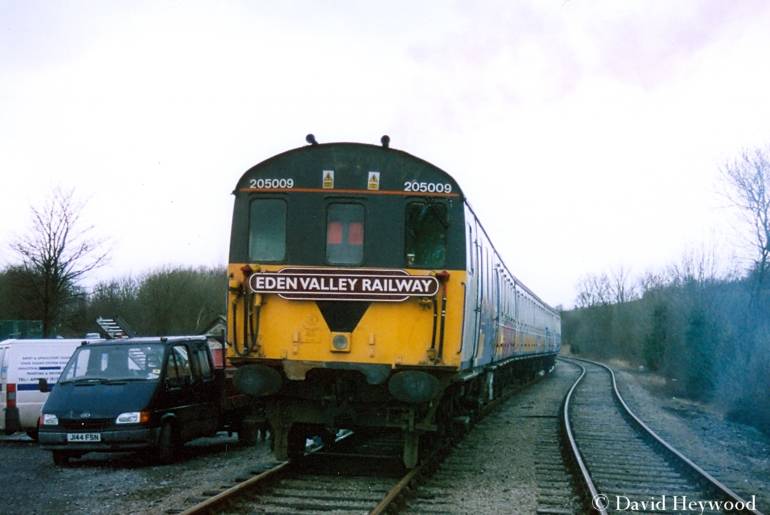
205009 accelerating away from Warcop Station in July 2009
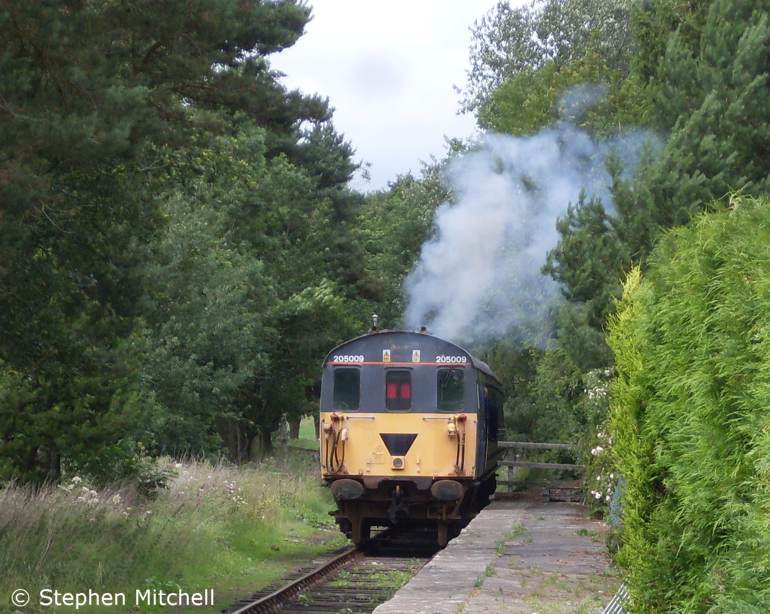
205009 carrying a bright new livery in August 2016.
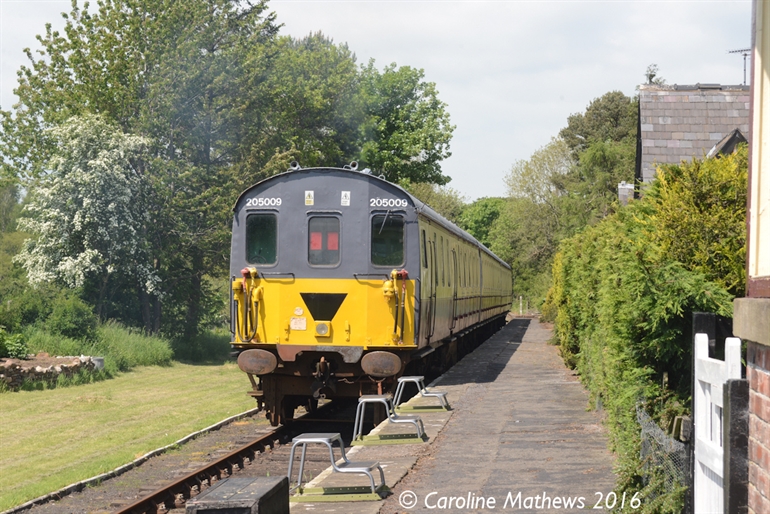
Motor Luggage Vans S68003, S68005 and S68010
These British Railways Motor Luggage Vans (MLVs) were built at Eastleigh in 1960, design code AF-1A, numbered S68003, S68005 and S68010. The MLVs were later given Class Number 419 and carried numbers 9003, 9005 and 9010.
A detailed history of the MLVs is to be found on the Southern Railway E-mail Group
S68003 and S68005 have now been at Warcop for quite some time. Since arrival S68005 has had a diesel generator installed which is used to supply power for lighting, heating, compressors and the MG sets of the 4-CEP when used in passenger service, enabling the batteries to power the train. Both MLVs have also had additional batteries installed to ensure there is enough power to complete a full day's service of journeys to Sandford Bridge and back. Both vehicles have had new batteries installed in recent years and they returned to passenger use in May 2019. More about this at the "Cumbrian Boat Train" page.
The third MLV to arrive at Warcop was S68010, which came from the Wensleydale Railway in 2012 in exchange for a Mark 1 coach. It was decided that 68010, devoid of most of its mechanical and electrical equipment, would be used as the new Emporium at Warcop, and work on the interior took place over the winter of 2012/13 to have the Emporium ready for the start of the 2013 passenger season at Easter.
MLVs 9003 and 9005 in the early days at Warcop
These British Railways Motor Luggage Vans (MLVs) were built at Eastleigh in 1960, design code AF-1A, numbered S68003, S68005 and S68010. The MLVs were later given Class Number 419 and carried numbers 9003, 9005 and 9010.
A detailed history of the MLVs is to be found on the Southern Railway E-mail Group
S68003 and S68005 have now been at Warcop for quite some time. Since arrival S68005 has had a diesel generator installed which is used to supply power for lighting, heating, compressors and the MG sets of the 4-CEP when used in passenger service, enabling the batteries to power the train. Both MLVs have also had additional batteries installed to ensure there is enough power to complete a full day's service of journeys to Sandford Bridge and back. Both vehicles have had new batteries installed in recent years and they returned to passenger use in May 2019. More about this at the "Cumbrian Boat Train" page.
The third MLV to arrive at Warcop was S68010, which came from the Wensleydale Railway in 2012 in exchange for a Mark 1 coach. It was decided that 68010, devoid of most of its mechanical and electrical equipment, would be used as the new Emporium at Warcop, and work on the interior took place over the winter of 2012/13 to have the Emporium ready for the start of the 2013 passenger season at Easter.
MLVs 9003 and 9005 in the early days at Warcop
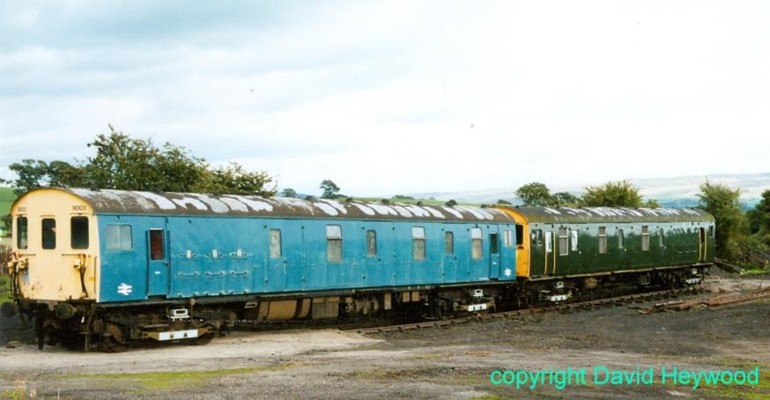
9005 and 9003 propelling 4-CEP 2315 towards Warcop in August 2009 with the exhaust from the diesel generator in 9005 clearly visible
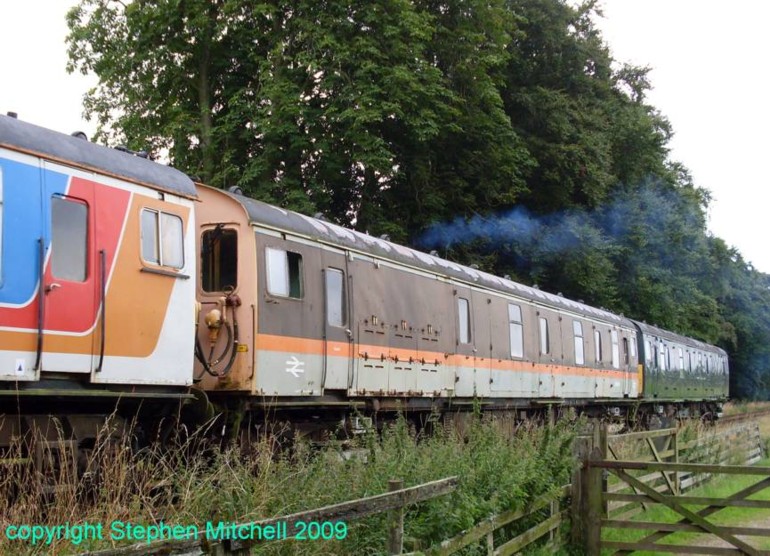
"Darlington" (RSHD8343/1962)
“Darlington” is an 0-6-0 diesel hydraulic shunter built by Robert Stephenson & Hawthorn Ltd in 1962 to a design of W Bagnall, works number 8343, and it bears a marked similarity to British Rail’s Class 04s. The locomotive initially worked at Coleshill Gas Works in the West Midlands and later moved to Thames Matex of Grays in Essex, remaining there until 2003 as the company name changed to Van Ommeren and then Vopak. The locomotive was purchased from Vopak in 2003 and moved to Warcop that year. The name Darlington was given in 2004, although the name plates were not attached until 2011. “Darlington” was much used as works train loco and site shunter until 2012 when a compressor problem put it out of use. This has now been rectified and the loco is back in working order and in use on works trains.
“Darlington” in the early days at Warcop, still in Vopak livery.
“Darlington” is an 0-6-0 diesel hydraulic shunter built by Robert Stephenson & Hawthorn Ltd in 1962 to a design of W Bagnall, works number 8343, and it bears a marked similarity to British Rail’s Class 04s. The locomotive initially worked at Coleshill Gas Works in the West Midlands and later moved to Thames Matex of Grays in Essex, remaining there until 2003 as the company name changed to Van Ommeren and then Vopak. The locomotive was purchased from Vopak in 2003 and moved to Warcop that year. The name Darlington was given in 2004, although the name plates were not attached until 2011. “Darlington” was much used as works train loco and site shunter until 2012 when a compressor problem put it out of use. This has now been rectified and the loco is back in working order and in use on works trains.
“Darlington” in the early days at Warcop, still in Vopak livery.
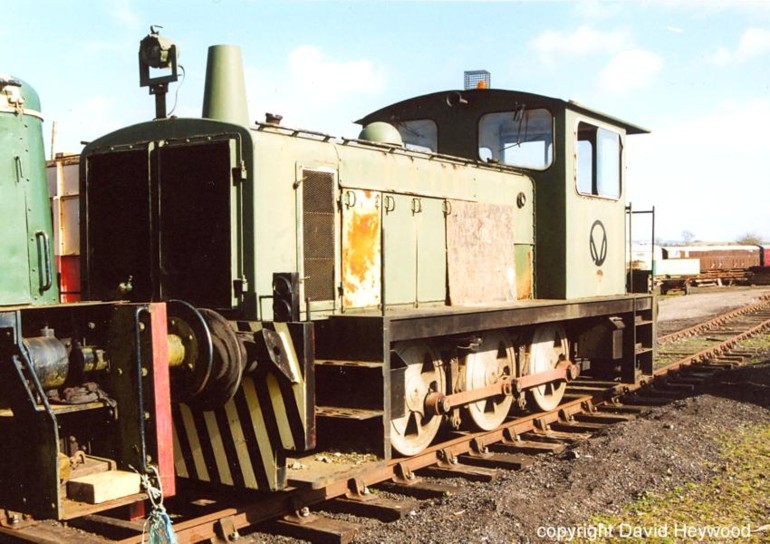
A cold start for “Darlington” on 28th February 2010
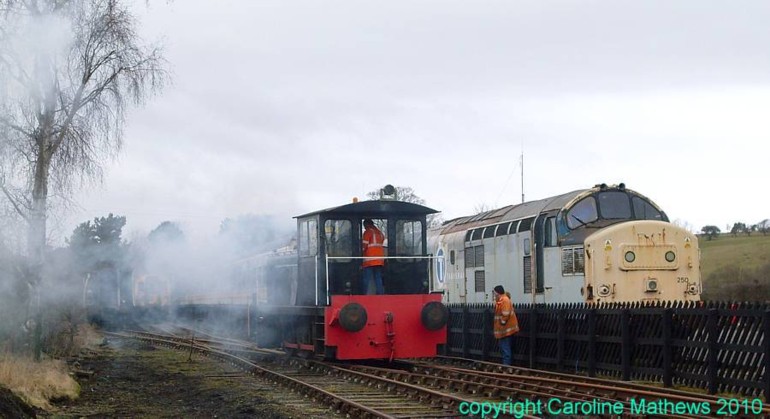
21 (Fowler 4220045/1967)
21 is an 0-4-0 diesel hydraulic locomotive built by John Fowler & Co of Hunslet, Leeds in 1967, works number 4220045. Its working life in industry was at the Shell Refinery at Stanlow before it entered preservation at the Lakeside and Haverthwaite Railway. It came to Warcop in 1999 and was the first working locomotive on site. Having been out of use and looking somewhat forlorn for some time following two aborted rebuilds it has been thoroughly overhauled and is now back in service, being the standby works locomotive and first choice when we offer "Driver for a Fiver".
21 seen at Warcop in the company of RSH8343
21 is an 0-4-0 diesel hydraulic locomotive built by John Fowler & Co of Hunslet, Leeds in 1967, works number 4220045. Its working life in industry was at the Shell Refinery at Stanlow before it entered preservation at the Lakeside and Haverthwaite Railway. It came to Warcop in 1999 and was the first working locomotive on site. Having been out of use and looking somewhat forlorn for some time following two aborted rebuilds it has been thoroughly overhauled and is now back in service, being the standby works locomotive and first choice when we offer "Driver for a Fiver".
21 seen at Warcop in the company of RSH8343
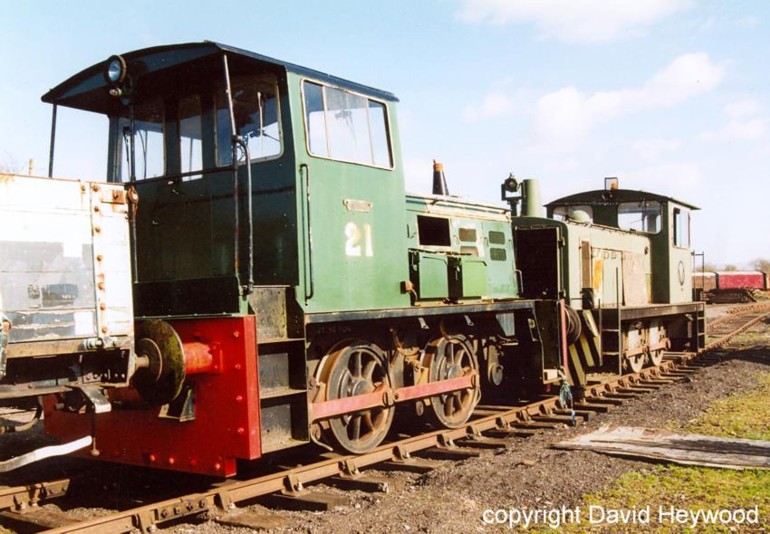
21 in November 2014, just before restoration began
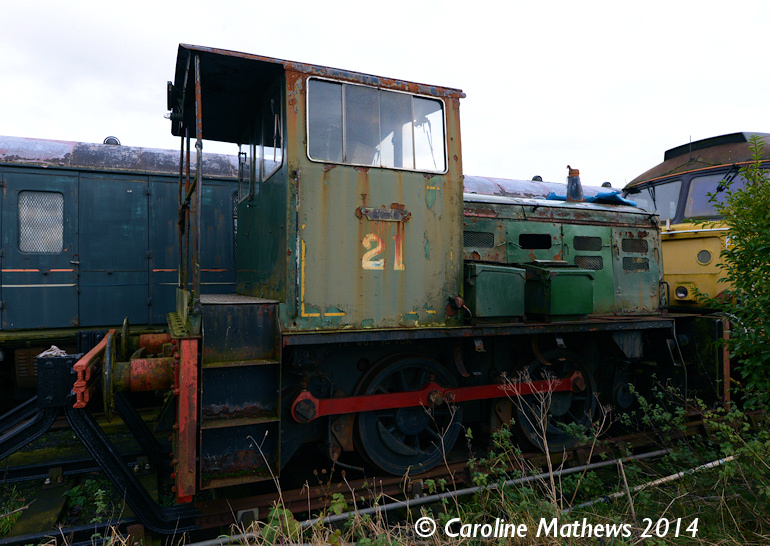
The newly restored 21 in August 2017
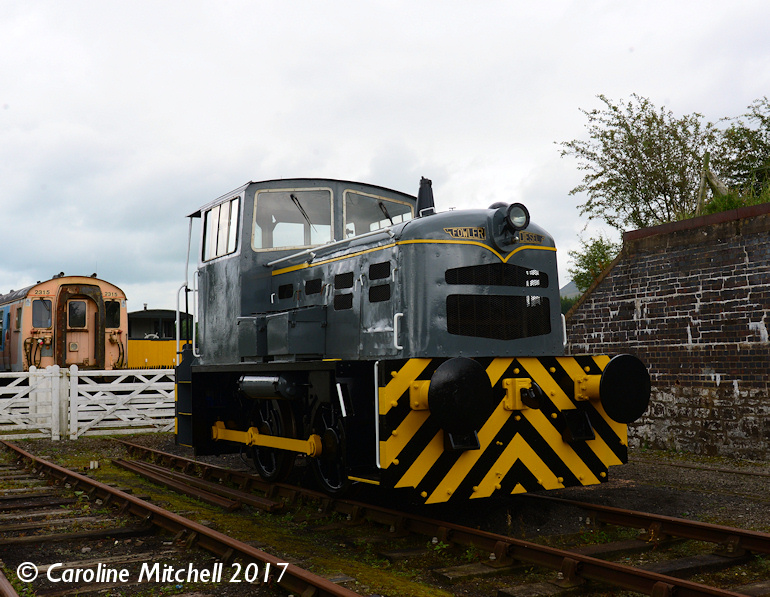
ND3815: Hunslet 2389/1941
Smallest and oldest of the three locomotives which came to Warcop from the Haig Colliery Museum in 2010 is this 0-4-0 diesel mechanical locomotive built by Hunslet in Leeds in 1941, works number 2389. It went into use at the naval armaments depot (RNAD) at Trecwn in Pembrokeshire and was given the number ND3815 which is still carried on a plate on one side of the loco. It moved to RNAD Broughton Moor in Cumbria in the late 1960s or early 1970s where it remained until the early 1990s when it went into storage at Threlkeld Quarry. By 2000 it had moved to Haig Colliery museum and was restored in time to make an appearance at the Corus 125 event in Workington in 2002. It moved to the Eden Valley Railway in September 2010 and is in full working order, although it’s weight restricts it to light shunting in the yard.
Many thanks to Nigel Attwood and Ken Scanes of the Industrial Railway Society for much of the detail given above.
Hunslet 2389/1941 shortly after arrival at Warcop in 2010
Smallest and oldest of the three locomotives which came to Warcop from the Haig Colliery Museum in 2010 is this 0-4-0 diesel mechanical locomotive built by Hunslet in Leeds in 1941, works number 2389. It went into use at the naval armaments depot (RNAD) at Trecwn in Pembrokeshire and was given the number ND3815 which is still carried on a plate on one side of the loco. It moved to RNAD Broughton Moor in Cumbria in the late 1960s or early 1970s where it remained until the early 1990s when it went into storage at Threlkeld Quarry. By 2000 it had moved to Haig Colliery museum and was restored in time to make an appearance at the Corus 125 event in Workington in 2002. It moved to the Eden Valley Railway in September 2010 and is in full working order, although it’s weight restricts it to light shunting in the yard.
Many thanks to Nigel Attwood and Ken Scanes of the Industrial Railway Society for much of the detail given above.
Hunslet 2389/1941 shortly after arrival at Warcop in 2010
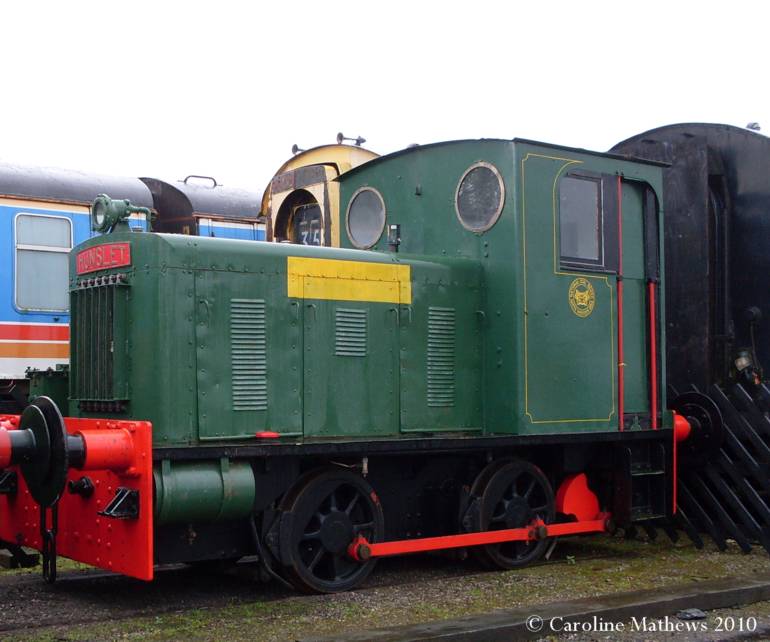
Thomas Hill 130c/1963
This is another of the locos from Haig Colliery Museum.
Thomas Hill of Kilnhurst rebuilt many steam and diesel locomotives in the 1960s, including 130c. This 0-4-0 diesel hydraulic was originally John Fowler diesel mechanical 0-4-0 22971 of 1942, the history of which is obscure. It is thought to have been allocated to ROF Birtley when new, but other than this nothing is known of its movements until it went to Thomas Hill for rebuilding in 1963.
The rebuilt loco was given works number 130c and went to ROF Pontrilas in Herefordshire. Subsequent movements saw the loco in use at MOD sites in Bicester, Quedgeley and Eastriggs before passing to J Walker of Annan, a dealer, in February 1984. It remained there until passing to the Haig Colliery Museum by 2005, and it moved to Warcop in September 2010.
The loco was used in the shunting necessary when 47799 arrived and was in regular use on the works train and as site shunter from “Darlington's” failure in early 2012 until late 2014 when wheel problems put it out of use. It is known at Warcop as “The Vanguard”.
Many thanks to Nigel Attwood and Ken Scanes of the Industrial Railway Society for much of the detail given above.
Thomas Hill 130c just after its arrival at Warcop in September 2010.
This is another of the locos from Haig Colliery Museum.
Thomas Hill of Kilnhurst rebuilt many steam and diesel locomotives in the 1960s, including 130c. This 0-4-0 diesel hydraulic was originally John Fowler diesel mechanical 0-4-0 22971 of 1942, the history of which is obscure. It is thought to have been allocated to ROF Birtley when new, but other than this nothing is known of its movements until it went to Thomas Hill for rebuilding in 1963.
The rebuilt loco was given works number 130c and went to ROF Pontrilas in Herefordshire. Subsequent movements saw the loco in use at MOD sites in Bicester, Quedgeley and Eastriggs before passing to J Walker of Annan, a dealer, in February 1984. It remained there until passing to the Haig Colliery Museum by 2005, and it moved to Warcop in September 2010.
The loco was used in the shunting necessary when 47799 arrived and was in regular use on the works train and as site shunter from “Darlington's” failure in early 2012 until late 2014 when wheel problems put it out of use. It is known at Warcop as “The Vanguard”.
Many thanks to Nigel Attwood and Ken Scanes of the Industrial Railway Society for much of the detail given above.
Thomas Hill 130c just after its arrival at Warcop in September 2010.
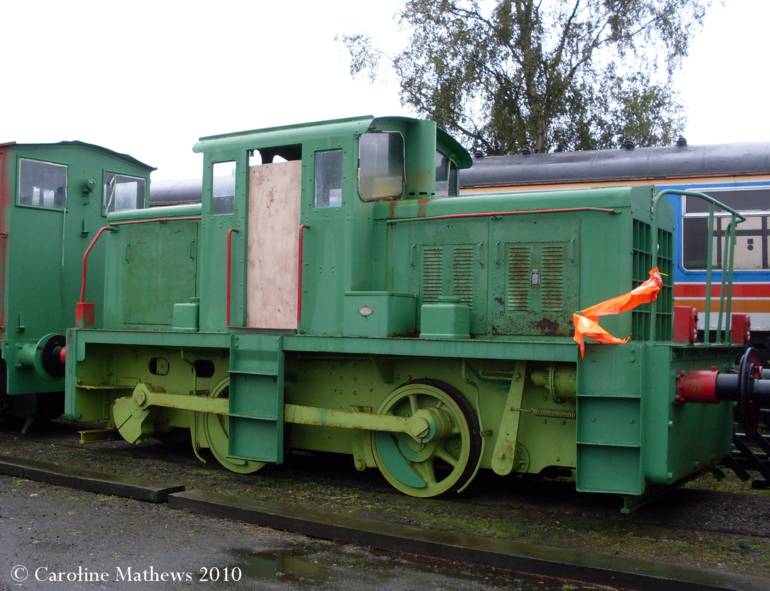
The Vanguard at Southfields with a ballast train on 12th February 2012.
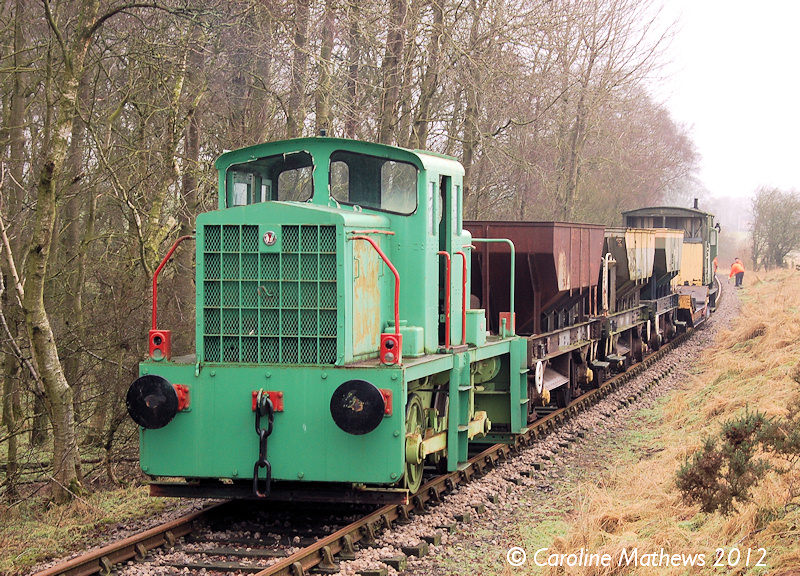
Drewry Cars 2181/1945 (Vulcan Foundry 5262/1945)
Third of the locos from the Haig Colliery Museum is known as the Barclay, it having been built to a design of Andrew Barclay of Kilmarnock. It was actually built in 1945 by Vulcan Foundry, works number 5262, to an order from Drewry Cars of London who gave it their number 2181.
It was ordered by the War Department during the Second World War but not delivered until after the end of the war. It entered service at Tidworth Camp in Wiltshire, moving in 1956 to one of the MOD sites in the Swindon area. Subsequent moves took the loco to ROF Bishopston near Glasgow and an army depot in Sudbury before an overhaul at Bicester in 1968, at which point a new engine was fitted. It’s next posting was to Stirling where it remained until closure of the site in 1984, being used in removal of materials off the site and then being sold to J McWilliams of Glasgow, a dealer. It remained with J McWilliams and then M & C Metals of Glasgow until 2003. A short period on hire to DRS in Carlisle in 2003 was followed by the move to Haig Colliery Museum in Whitehaven where it remained until September 2010.
Although the loco is in a rather odd shade of undercoat/primer it is operational and has been used during stock shunts at Warcop. After the Vanguard failed in 2014 it was in use as works train locomotive until Fowler 21 was repaired to an operational state in late 2016. Many thanks to Nigel Attwood and Ken Scanes of the Industrial Railway Society for much of the detail given above.
“The Barclay” (Drewry Cars 2181/1945) at Warcop in September 2010.
Third of the locos from the Haig Colliery Museum is known as the Barclay, it having been built to a design of Andrew Barclay of Kilmarnock. It was actually built in 1945 by Vulcan Foundry, works number 5262, to an order from Drewry Cars of London who gave it their number 2181.
It was ordered by the War Department during the Second World War but not delivered until after the end of the war. It entered service at Tidworth Camp in Wiltshire, moving in 1956 to one of the MOD sites in the Swindon area. Subsequent moves took the loco to ROF Bishopston near Glasgow and an army depot in Sudbury before an overhaul at Bicester in 1968, at which point a new engine was fitted. It’s next posting was to Stirling where it remained until closure of the site in 1984, being used in removal of materials off the site and then being sold to J McWilliams of Glasgow, a dealer. It remained with J McWilliams and then M & C Metals of Glasgow until 2003. A short period on hire to DRS in Carlisle in 2003 was followed by the move to Haig Colliery Museum in Whitehaven where it remained until September 2010.
Although the loco is in a rather odd shade of undercoat/primer it is operational and has been used during stock shunts at Warcop. After the Vanguard failed in 2014 it was in use as works train locomotive until Fowler 21 was repaired to an operational state in late 2016. Many thanks to Nigel Attwood and Ken Scanes of the Industrial Railway Society for much of the detail given above.
“The Barclay” (Drewry Cars 2181/1945) at Warcop in September 2010.
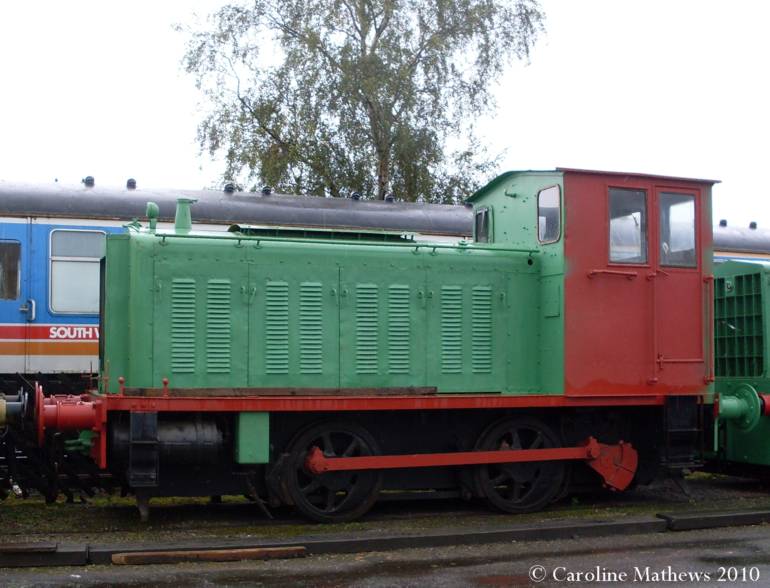
“Barclay” down the line on a works train in November 2014
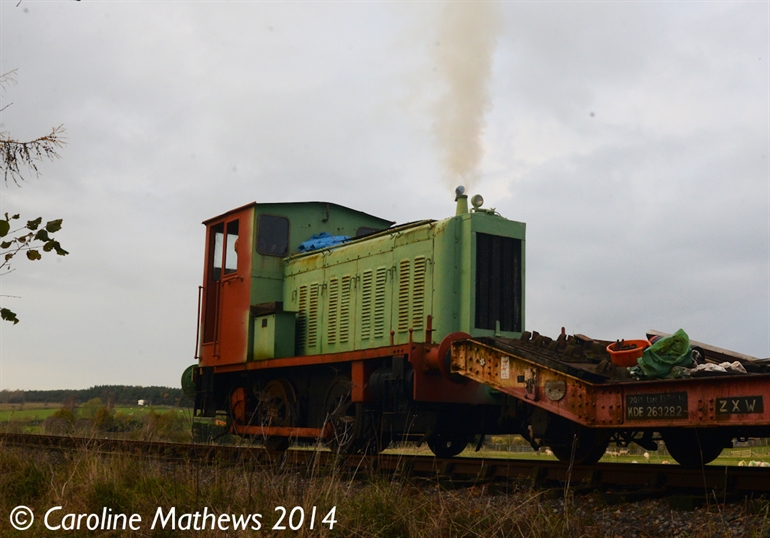
15 ton Crane and Match Wagon
DRT81343 is a Taylor & Hubbard CCE heavy duty diesel electric crane, built in 1966. It appears to have been based at Eastleigh for a long time, followed by a spell at Woking. It moved from Woking to the Eden Valley Railway in 2001. The match wagon is DS70281, originally Southern Railway TFK S12235S built in 1937 by Metro Cammell to diagram 2506 for the 4-RES units.
The crane was the first item of stock to move through Warcop Station under its own power and saw much use during track relaying in the yard. It is currently out of service but repair is underway.
The crane in use at Warcop in the early days of the preservation scheme.
DRT81343 is a Taylor & Hubbard CCE heavy duty diesel electric crane, built in 1966. It appears to have been based at Eastleigh for a long time, followed by a spell at Woking. It moved from Woking to the Eden Valley Railway in 2001. The match wagon is DS70281, originally Southern Railway TFK S12235S built in 1937 by Metro Cammell to diagram 2506 for the 4-RES units.
The crane was the first item of stock to move through Warcop Station under its own power and saw much use during track relaying in the yard. It is currently out of service but repair is underway.
The crane in use at Warcop in the early days of the preservation scheme.
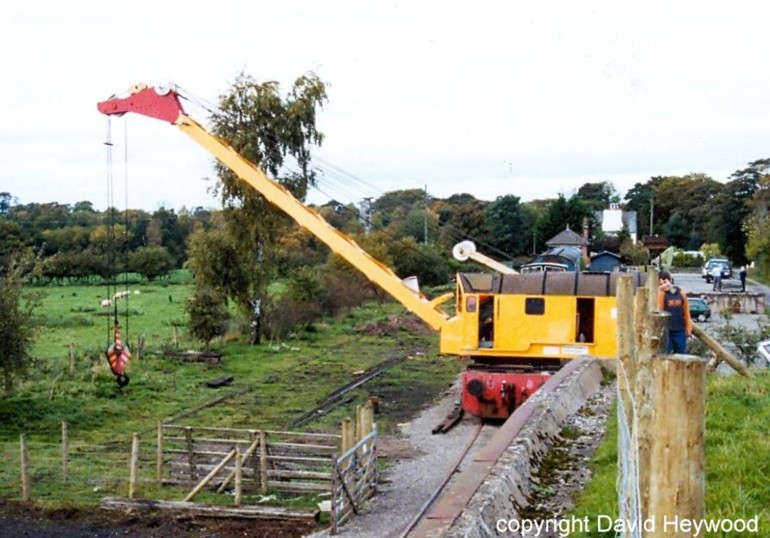
The crane in October 2016, by which time the electrical problems had been resolved and the crane runner frame was being refurbished. Work is still ongoing, with all the runner’s decking currently being replaced.
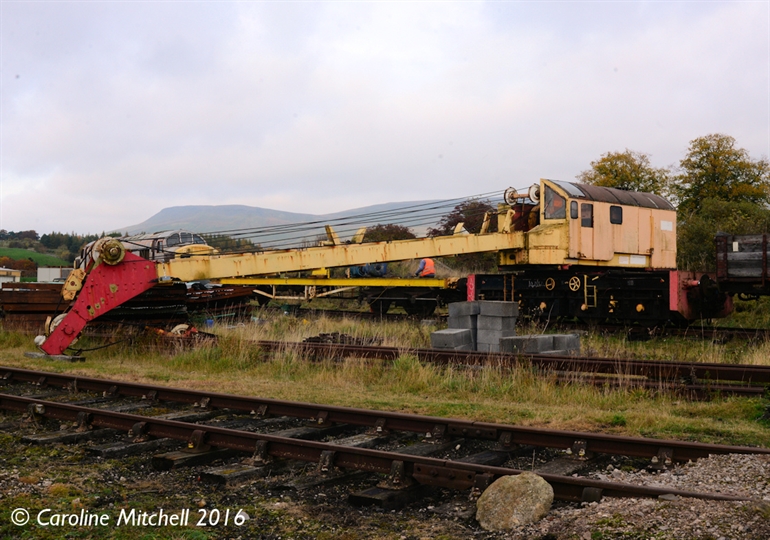
Wickham Trolley "DE320468"
Built by Wickham of Ware in 1932, works number 1724, this trolley is fitted with a JAP 1323cc petrol engine. It was sold by British Railways to the North Yorkshire Moors Railway in 1969. It moved in 2000 to Ian Storey Engineering at Hepscott and arrived at Warcop in 2001. It was out of use for a long time, but one of our mechanical wizards has got it running again although it is rather temperamental.
The number carried is erroneous and was applied at some point in preservation. It has recently been established that our Wickham carried the number 950042 and was considerably older than we had been led to believe when it first arrived.
A fine side view of the Wickham in the early days at Warcop
Built by Wickham of Ware in 1932, works number 1724, this trolley is fitted with a JAP 1323cc petrol engine. It was sold by British Railways to the North Yorkshire Moors Railway in 1969. It moved in 2000 to Ian Storey Engineering at Hepscott and arrived at Warcop in 2001. It was out of use for a long time, but one of our mechanical wizards has got it running again although it is rather temperamental.
The number carried is erroneous and was applied at some point in preservation. It has recently been established that our Wickham carried the number 950042 and was considerably older than we had been led to believe when it first arrived.
A fine side view of the Wickham in the early days at Warcop
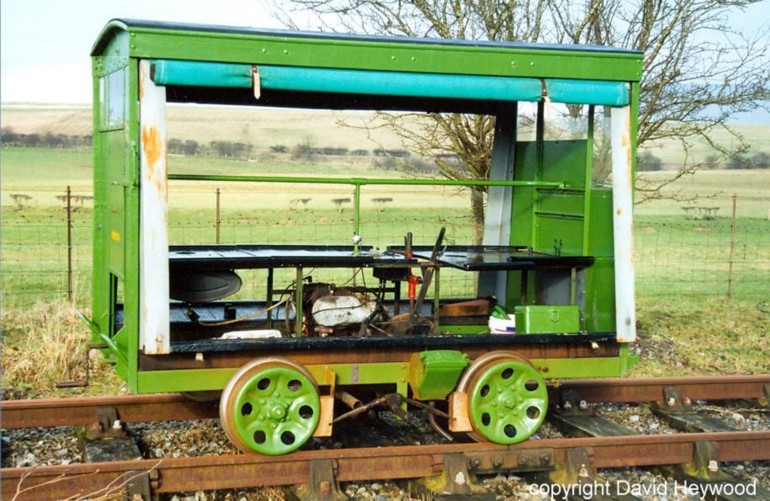
The Wickham down the line back in the days when grass and weeds proliferated.
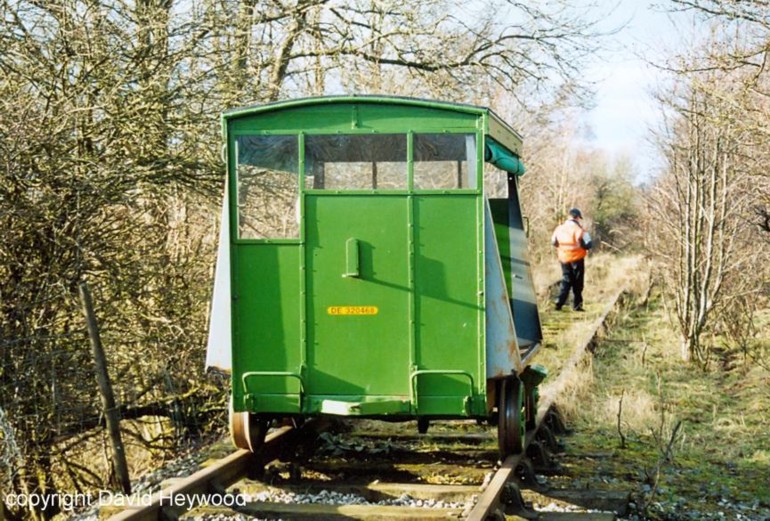
The Wickham being turned prior to its first run down the line for many years, in August 2015.
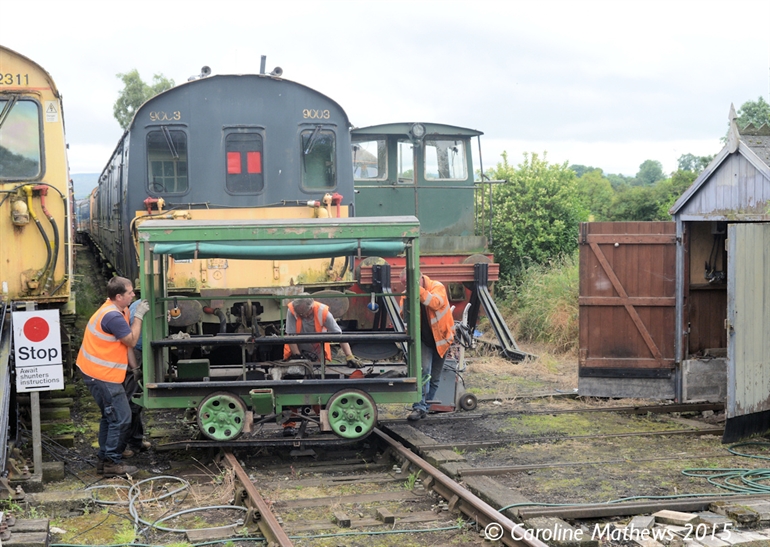
Fred
An invaluable part of the rolling stock, Fred has seen much with the permanent way gang, helping with both the maintenance of the permanent way and the fitness of the gang. It is thought to be of Swedish or Danish origin, possibly dating from the 1970s. Fred received a new coat of paint in 2009 prior to visiting the Churnet Valley Railway for the 9th annual velocipede rally.
Fred parked at Warcop just after the repaint in 2009
An invaluable part of the rolling stock, Fred has seen much with the permanent way gang, helping with both the maintenance of the permanent way and the fitness of the gang. It is thought to be of Swedish or Danish origin, possibly dating from the 1970s. Fred received a new coat of paint in 2009 prior to visiting the Churnet Valley Railway for the 9th annual velocipede rally.
Fred parked at Warcop just after the repaint in 2009
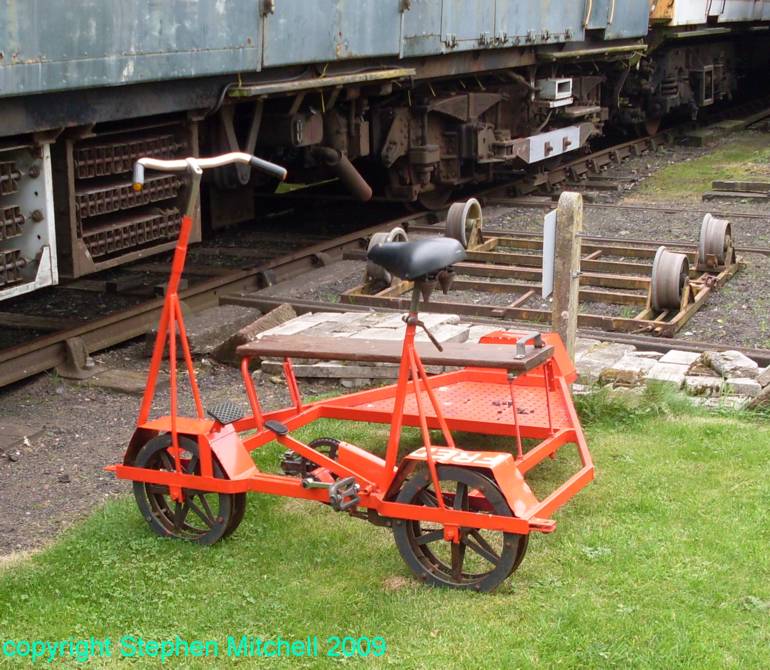
Fred at the fence near Old Hall Farm in June 2017 during the Velocipede Rally. More photos of the rally can be seen in the Galleries section.
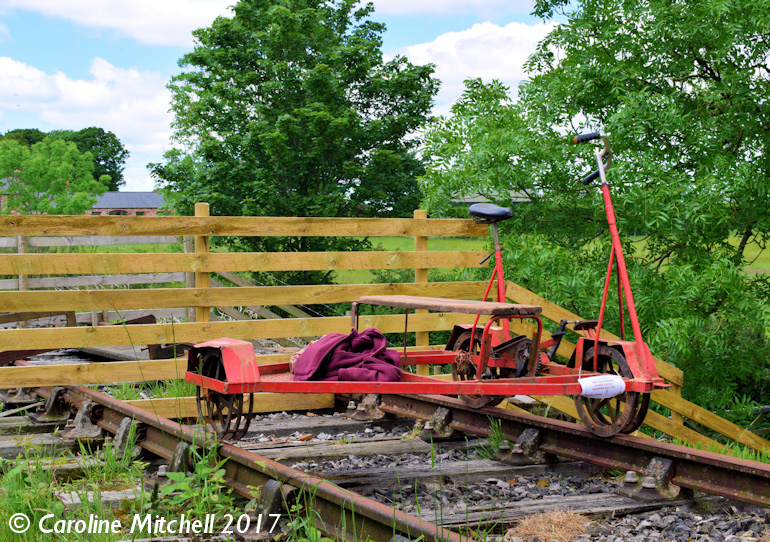
Last updated on 16th July 2020 by Caroline Mitchell